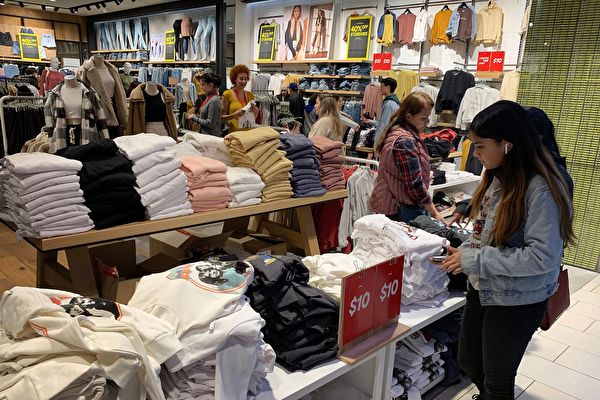Retailers in the United States are currently feeling uneasy as consumers are no longer spending as generously as before. In a game of chicken between buyers and sellers, retailers have taken the first step by surrendering and deciding to lower prices on thousands of products.
Let’s first take a look at the overall economic situation in the United States. Inflation over the past two years has driven up prices, putting pressure on Americans and forcing consumers to make choices between “needs” and “wants,” prioritizing the purchase of essential goods.
This trend not only affects individual shopping habits and large retail chains but also has implications for the overall U.S. economy as two-thirds of the U.S. GDP comes from consumer spending.
Recently, many retailers have started announcing price cuts with the goal of attracting more consumers. IKEA has significantly reduced prices on hundreds of products. In April this year, 18-piece dinnerware sets at IKEA went from $49.99 to $29.99, glass-door bookcases dropped from $229 to $189, and bed frames with storage and headboards saw prices decrease from $549 to $499. These are all non-essential items.
According to CNN, Sarah Wyeth, Managing Director of Global Ratings for Retail and Consumer Sectors at S&P, stated that with prices being 20-30% higher than three years ago and incomes not keeping up, consumers are leaning towards conservative shopping habits, a trend that has been ongoing for a year.
“This has led consumers across different income levels to seek value-for-money products, where ‘bargain-hunting’ is no longer exclusive to the middle to lower-income groups. So far, the most significant decline in consumer willingness to spend has been among high-income groups, who were previously less affected by economic downturns and are now tightening their purse strings,” Chad Lusk, Managing Director of Consumer and Retail Group at global consultancy firm Alvarez & Marsal, commented.
“In general, retail sales figures are not terrifying, but they are not also as good as expected,” said Zak Stambor, Senior Analyst for Retail and E-commerce at market research company eMarketer, in an interview with CNN.
According to the latest government report, retail sales increased by 0.7% in March, slower than the 0.9% growth in February. This exceeded the 0.4% growth predicted by economists, as per a survey by FactSet.
Until March this year, retail spending increased in seven out of ten months. During this period, spending on services such as automobiles, e-commerce, restaurants, travel, and entertainment increased, but purchases of furniture, clothing, sports goods, and electronics remained sluggish.
Stambor noted that businesses are looking to change this situation, stating that “many retailers have indicated that non-essential spending is slowing down. People are savvier than before, they only buy necessities, and then head back home.”
He suggested that retailers consider promoting high-priced non-essential items to increase purchase frequency.
Stambor also proposed, “To persuade consumers to spend, you must give them a reason. Lower prices are clearly a key point.”
For Walmart, price reduction is a timeless strategy. Walmart announced last December that it would lower grocery prices this year. Stambor mentioned that enhancing consumer value through promotions is a highly effective strategy, saying, “Even after spending a lot of money, consumers still prioritize the value of the products.”
Jesper Brodin, CEO of Ingka Group (the Dutch holding company for IKEA Retail), told CNN in March, “Compared to before, we are not holding back on price reductions this time. As people have less money in their pockets, we have lowered prices.” Brodin added, “The past six to eight months have seen unprecedented slow sales.”
Michaels, an arts and crafts store with over 1,300 locations in the US, announced in early April that it would reduce prices on 5,000 products. Ashley Buchanan, CEO of Michaels, stated in a press release on April 18th that “providing exceptional value to every customer is more important now than ever.”
Specifically, prices of common products at Michaels such as paints, markers, and pens were reduced by up to 15%; glue, paper, and stickers saw a 20% decrease in prices; and the prices of painting canvases may have been slashed by up to 35%.
Clothing retailer H&M also plans to lower prices. Lars Daniel Ervér, CEO of H&M, stated during a phone conference in March, “By the end of this year, our prices will be even lower than at the beginning of the year.”
Other retailers attempting to win over consumers have also joined this price war. Baby care product manufacturer Frida announced in February that it had reduced the price of its flagship product NoseFrida (baby nasal aspirator) from $17.99 in 2014 to $14.99, along with price cuts on other products.
Restaurant and children’s entertainment chain Chuck E. Cheese unveiled an “Economic Value” marketing program aimed at attracting family customers. The company stated that it is reducing game prices and offering a 50% discount on food and beverages as part of a new summer promotion.
Analyst Stambor from market research firm eMarketer believes that besides cutting prices, retailers will introduce more loyalty rewards campaigns or limited-time offers to drive sales.
Note: [1] “the game of chicken” is a concept in game theory where two drivers drive towards each other on a collision course, and the one who swerves first is considered the “chicken,” while the other wins.

